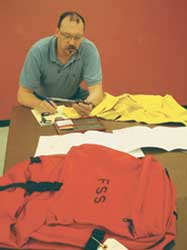Missoula Technology and Development Center: Shaping Solutions for the Forest Service
Contracts Save Big Bucks
Buying firefighting equipment through contracts saved taxpayers an estimated $34 million last year compared to the cost of buying the same items in small quantities. The purchases are based on contract specifications established by Forest Service technology and development centers in Missoula, MT, and San Dimas, CA.
Savings add up when you consider how much equipment is needed each season by firefighters in the Forest Service, Bureau of Land Management, National Park Service, Bureau of Indian Affairs, Fish and Wildlife Service, and other agencies.
Last year, agencies ordered 129,455 pairs of the newest model of flame-resistant pants for a savings of almost $9 million. Another $3 million was saved buying 73,221 yellow flame-resistant shirts.
Dennis Davis is in charge of specifications at the center. He specifies the requirements a contractor must meet when mass-producing flame-resistant shirts or other items. Technical drawings show a contractor the exact dimensions of each item.

Dennis Davis inspects items to make sure
they meet contract specifications.
In many cases, these items would not exist without the Forest Service's technology and development centers. Prototypes of the flame-resistant shirt and pants, fire shelter, and similar items were developed and tested by the technology and development centers. The final specifications allow contractors to produce the items in large quantities for field use.
The General Services Administration provides the specifications when soliciting bids from contractors. Once a contract has been awarded, Davis inspects the "first article" to make sure the product meets the specifications. The contractor has to correct any mistakes in materials or construction before large quantities of the item may be produced for the Forest Service.

Savings for firefighters' protective clothing purchased during 2001
(Hardhats: $163,000 saved; Gloves: $920,000 saved; Shovels: $184,000 saved;
Pants: $8.9 million saved; Shirts: $3.3 million saved).
